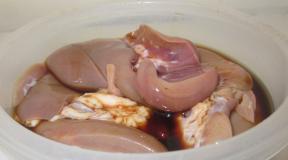How to distinguish an encephalitis tick from a regular one. Encephalitis tick - how does the dangerous virus manifest itself? Why are the symptoms not the same for everyone?
Encephalitis is a viral infection, the foci of spread are directly related to the habitats of its carriers – encephalitis ticks. The virus that causes the disease was discovered in 1937. It was found in wild animals, ixodid ticks, and also isolated from the membranes of the brains of dead patients. The main symptoms are severe intoxication and fever.
The disease affects the brain and spinal cord, causing serious consequences, including death.
Natural carriers of the disease are wild animals:
- ungulates;
- predators;
- small rodents;
- insectivores.
It is transmitted from wild animals to ticks, and through their bites to domestic animals and humans. Once infected, the arachnid infects all of its offspring. The incubation period is 7-14 days.
General information about encephalitis ticks, description of their appearance

Let's look at what an encephalitis tick looks like. The body of ixodid ticks has a size of no more than 4 mm, externally resembles an oval-shaped pouch, legs and proboscis are attached to it. The proboscis is often called the head, but this is incorrect, the proboscis is the oral apparatus, the brain is located in the center of the body.
In this they differ from other arachnid species; their body consists of a cephalothorax and abdomen. When hungry, the creature has a flat shape.
The female differs from the male in the size of the dorsal shield: in males it covers the entire back, in females it covers only a third of the back, which makes her body elastic. This is important, because the female’s body, after she drinks blood, increases up to 15 times in size and becomes a lead-gray hue. Having drunk blood, the female leaves offspring and then dies. The food for tick larvae and nymphs is the blood of reptiles, birds, and small mammals.
Types of ticks dangerous to humans
The carriers of the encephalitis virus in our latitudes are two types of ticks:
- taiga;
- canine.

Infection with encephalitis also occurs through bites of other types of ticks, but such cases are isolated and extremely rare.
The taiga and dog species are similar in shape and size. The taiga tick differs from its fellow tick in the brighter color of its abdomen - from bright orange to dark red. The abdominal part of the dog tick is gray, ranging from light to dark. Having drunk blood, the male leaves his victim. The female remains on the host's body for several days or even a week, feeding on blood and preparing for childbirth.
Knowing how to distinguish an encephalitis tick from a regular one, you can provide timely assistance to the victim and avoid serious consequences. Only special laboratory tests can determine whether a particular tick is a carrier of the virus.
Areas of distribution of encephalitis ticks
Signs of encephalitis virus infection
The most common signs of infection:
- fever, a sharp increase in body temperature to +39° C and above;
- general malaise, body aches, flu-like symptoms;
- dizziness, headaches;
- nausea, vomiting;
- weakness.

Fever or fever are characteristic signs of the active development stage of the virus for up to 10 days. The matter may be limited to this. Then doctors talk about a mild form of encephalitis, which can give the victim lasting immunity to the disease. Sometimes primary fever precedes the chronic form of the disease.
Sometimes after the fever subsides, a period of remission occurs, lasting about a week. Then a relapse occurs, the virus attacks the nervous system, and the disease progresses to a severe form - meningeal. Internal organs are affected, where encephalitis actively develops. The disease is accompanied by photophobia and pain in the occipital muscles of the neck. Sometimes the virus affects the brain, which leads to hallucinations.
What to look for
It is important to prevent such situations and seek medical help in time. The doctor needs to collect all the information and draw up a complete clinical picture of the disease, since similar symptoms are possible with some viral infections or diseases of the central nervous system.

Preventing tick bites
Encephalitis is much easier to prevent than to treat for a long time. Every year, about half a million Russians seek medical help due to tick bites. Of this number, encephalitis is found in 2-3 thousand people, about 30 people die from the virus per year.
Pets are also susceptible to bites. Therefore, when you take your dog with you, you should put a collar treated with acaricidal agents on it, and also treat the dog’s withers with special drops or spray.
There is a set of preventive measures for encephalitis:
- vaccination;
- insurance;
maintaining order, anti-tick treatment of the garden plot.
You need to remove the tick as soon as possible. It is advisable to do this in a hospital, emergency room or other medical facility.
First, the bite is disinfected, and then the head is pulled out with a sterile needle, after which the wound is disinfected again. Disinfection does not guarantee that the infection will not enter the blood, but the chance of a favorable outcome will increase. At a minimum, there will be no purulent blister. Then the bite site is lubricated with ointment (hydrocartizone, Advantan, Pimafucort, Flucinar) so that the bite heals faster and does not become inflamed.
If there is no doctor nearby, you will have to get the tick out with your own hands. Several rules must be followed:

If after a bite a rash similar to hives spreads throughout the body, you need to take antihistamines (Suprastin, Loratadine, Ebastine) and/or call an ambulance as soon as possible. This is an allergic reaction of a hypersensitive person immediately after being bitten. The patient's condition will quickly deteriorate, so there is not a minute to lose.
What does an encephalitis tick and its bite look like?
 Enlarged photo of an ixodid tick infected with encephalitis.
Enlarged photo of an ixodid tick infected with encephalitis. The tick chooses places with good blood circulation and thin skin that are hidden under clothing:
- area behind the ears;
- armpits;
- breast;
- stomach;
- small of the back;
- groin area.
 The picture shows the most favorite places where ticks bite.
The picture shows the most favorite places where ticks bite. At the site of the bite, you will most often notice a small black or brown insect with four legs on the sides. The more blood he sucks, the larger his body. It clings to the skin with the help of a hypostome, a small proboscis in front. It is impossible to distinguish a sterile tick from an infected one by appearance. Only analysis in the laboratory will show an unambiguous result.
The bite site is a red dot, similar to a mark from a strong pinpoint blow. The skin around it turns red, a swollen ring appears, but it may not exist.
Redness and slight swelling are a standard allergic reaction to tick saliva, but if the red spot grows to ten centimeters or more, then this is already a sign of Lyme disease.
How does a tick infect a person with encephalitis?

Tick research in the laboratory
It is important to preserve the tick for the laboratory, because only there can it be thoroughly studied and understand what infections it has transmitted to the affected person and whether it has suffered at all. This procedure is called a tick test. The diagnosis, therapy and selection of medications for the patient depend on it.

When going to the hospital, you need to clarify the question of simultaneous testing not only for encephalitis, but also for other infections. The tick will not be returned, and you will not be able to go to another laboratory with a new request.
A tick test takes on average three days, but in private clinics it can take 12 hours. If the test is positive, the person will be given gammaglobulins within three days. To find out the result, you can call the hospital yourself, but according to the rules, the doctor is obliged to inform the infected patient about the diagnosis.
Forms of encephalitis
The main forms of tick-borne encephalitis:
- Feverish: Can be found in more than fifty infected people. The consequences are not fatal, but the fever lasts about a week. A distinctive feature of this form: the temperature either drops or rises again. When the condition returns to normal, all that remains is weakness, poor appetite, sweating and rapid heartbeat. Recovery may take 4 weeks.
- Meningeal: Occurs in only a third of patients. The form is so called because in the first days after the bite, encephalitis is confused with meningitis due to similar symptoms: due to brain damage there is a headache, fever, tense muscles (a person cannot even straighten a leg or arm), very sensitive skin. Fever and chills last for 1.5-2 weeks, weakness can persist for up to two months.
- Focal: Occurs in twenty percent of patients. The most severe and life-threatening form, as it can cause disability and death. The virus directly affects the brain and/or spinal cord. First there is a fever for several days (there may be hallucinations), and only then all the signs of encephalitis appear (lethargy, nausea, tremor, chills, headache, back pain).
- Poliomyelitis: The rarest (1% of patients), but very dangerous form. Complications often occur, which can also lead to disability and death. Can be identified by signs: disturbances in movements, numbness of the limbs, muscle weakness, general lethargy, the patient cannot hold his head straight or raise his arm).
- Chronic: Symptoms of encephalitis appear and intensify gradually. The main impact falls on the nervous system, problems with reflexes appear, and sometimes epileptic syndrome appears.

Clinical picture of the development of encephalitis
The mild course of the disease is characterized by mild symptoms; encephalitis is still difficult to diagnose. The disease is divided into two stages: fever and damage to the nervous system. When there is slight relief from the fever, the virus begins to cause damage to the brain and/or spinal cord.
After treatment with immunoglobulin, the residual effects of encephalitis will disappear:
- After a month, if the course of the disease is mild.
- After 2-4 months, if the disease is of moderate severity.
- After a year, if the encephalitis was very difficult to tolerate.
Why are the symptoms not the same in all people?
Different symptoms occur for several reasons:
- Different subtypes of the virus (the Siberian subtype is very dangerous, the Western or European subtype is moderately dangerous, the Far Eastern subtype is a violent manifestation often with a fatal outcome).
- General health and immunity. The weaker a person is, the more severe encephalitis is for him.
- The amount of encephalitis virus and other infections that have entered the blood.
- Time to provide medical care.
- The virus can attack different organs in different people, which also affects the clinical picture.
Symptoms of tick-borne encephalitis in a child
The first couple of weeks the virus does not manifest itself in any way. If the child has been given immunoglobulin, this period is extended for three weeks. Encephalitis always worsens sharply: the temperature reaches 40 degrees. This is the main sign; the rest depend on the child’s individual data:
- Migraine;
- Severe drowsiness;
- General weakness and lethargy;
- Difficult to swallow;
- Red face;
- Loss of voice or speech impairment;
- Repeated vomiting;
- Lower back pain;
- Photophobia;
- Convulsions;
- Tongue paralysis;
- Muscle pain and weakness;
- Dilatation of blood vessels in the eyes;
- Impaired consciousness;
- Heart failure;
- Arrhythmia;
- The body is exhausted, the condition is getting worse.
Consequences of infection
Infections carried by ticks can cause damage to various human organs:
- Nervous system: migraine, encephalitis, paralysis, tremor, epilepsy, encephalomyelitis, hyperkinesis.
- Joints: arthritis, arthralgia.
- Heart: arrhythmia, unbalanced blood pressure.
- Kidneys: nephritis, glomerulonephritis.
- Liver: poor digestion.
- Lungs: pneumonia and other consequences of pulmonary bleeding (cough, heavy and painful breathing).
Treatment of encephalitis
The result of treatment primarily depends on timely medical care. Taking medications, caring for the bite, and closely monitoring the patient's condition will prevent unpleasant surprises. There is a main treatment method and an additional one that will help improve health during and after illness.
Immunoglobulin
Administration of immunoglobulin to an infected person is an emergency prophylaxis against encephalitis. The drug binds to virus particles and deactivates them. Thus, the development of the virus stops, and the disease itself is stopped. This method can be used immediately after the bite, preferably within the first two days. The deadline is 4 days. This is its advantage over conventional vaccination. Immunoglobulin is considered the most effective and convenient treatment method today, since more than 90% of infected people do not develop encephalitis.

If the disease does develop, you still need to take immunoglobulin and, along with it, take a course of anti-intoxication medications. Within a few days the patient will feel better and the symptoms will begin to subside.
In reality, getting an injection is not easy. Poor organization of work in the hospital. Stocks of the drug are quickly running out due to the large number of patients. In private clinics, the medicine costs quite a lot, since it is imported from abroad. There, immunoglobulin production decreases because the number of tick bites decreases. For this reason, the medicine is in short supply and its price is rising.
Folk remedies
Ticks cope well with cold, but die at high temperatures. The same thing happens with the virus. In cool conditions it can exist for years, at room temperature the incubation period lasts a couple of weeks, and at boiling water temperatures it is immediately destroyed. It is the temperature of the environment in which the virus is located that determines how long it takes for symptoms to appear. For this reason, it is advisable to sit in a bathhouse for two hours and conduct such sessions for three days in a row.
At the same time, you need to take a warm decoction of pine needles and aspen bark eight times a day. 1 tablespoon of pine needles and 1 tablespoon of aspen bark should be poured with 500 ml of boiling water. Then the broth is infused for an hour.
Complications
Complications appear if medical care was not provided in the required time frame, the person was initially in poor health, and encephalitis was quite severe. Possible consequences of the disease:
- Terrible headaches.
- Meningitis.
- Poor coordination, paralysis, paresis.
- Breathing problems.
- Deterioration of hearing, vision, taste, skin sensitivity.
- Mental disability, poor memory.
- Incontinence.
- Psychical deviations.
- Personality degeneration, changes in consciousness, hallucinations.
All of the above complications arise due to too severe damage to the brain and/or spinal cord. They are responsible for movements, nerve impulses, the functioning of the senses and the psyche.
Prevention methods
Ideally, it is necessary to get vaccinated, since after infection the vaccine is strictly prohibited. This procedure is not only useless, but also harmful. The vaccine is a weaker version of the virus, but it will make the disease worse. The vaccine is mandatory for everyone who frequently comes into contact with the forest, and is desirable for those who are planning to relax in nature in the near future.

The vaccination should be done a month before traveling to a tick habitat, the deadline is two weeks before departure.
You must wear the correct clothing in an unsafe area. These are sweaters with long sleeves, pants with long legs. You should cover your neck with a high collar or scarf. Depending on the time of year, you can wear thermal underwear: due to the tight fit, it will not allow insects to reach the groin area, one of the main targets of ticks on the body. The head must be covered with a hood.
Among the supplies there should be a first aid kit to immediately treat the bite site.
When walking, you should avoid bushes and tall grass; it is better to cross the forest along a well-trodden path.
What other diseases do ticks carry?
In addition to typical encephalitis, ticks carry many equally dangerous diseases. They are listed below by decreasing prevalence:
- Lyme disease (borreliosis).
- Ehrlichiosis.
- Relapsing tick-borne typhus.
- Tuleramia.
- Babesiosis.
- Spotted fever.
The first three diseases are especially difficult for humans. They often become chronic, and full recovery from them can take a whole year.
With the appearance of bright greenery, it’s time for picnics in nature: at the dacha, outside the city or in forested areas. But the formidable encephalitis tick spoils the spring holiday. This creature is capable of infecting a person with a viral infection, usually leading to severe disability and even death.
In our country, encephalitis is carried by two types of ixodid ticks - the taiga tick and the dog tick. The first species is distributed over vast territories of the Urals, Siberia and the Far East, and the second - in the middle zone and in the north of the European part.
Every year, half a million Russians visit medical institutions with bites from these two types of ticks. Among the entire mass of applicants, 2000-3000 people are diagnosed with encephalitis. On average, 30 of them die within a year.

How to protect yourself from encephalitis tick
The threat of tick-borne encephalitis requires increased attention from everyone. When going to the lake for barbecue or just a walk in the forest, follow simple safety measures:
These simple rules will protect anyone from health problems.
Before delving into the theory of determining infection in the blood of a person infected with encephalitis after a tick bite, it is necessary to somewhat generalize the knowledge. The thing is that there are many types of ticks at the present stage, so you need to know what exactly you are dealing with. Among the most common types of ticks that pose the greatest danger are the following representatives:
- encephalitic. As a rule, insects of other species can also fall into this category, since ticks of all varieties can transmit diseases. The key danger of this group of insects lies precisely in the infection, which can enter your body through a bite. Moreover, it is impossible to determine by the appearance of a tick whether it is infected or not. Therefore, you will have to resort to the help of doctors;
The most difficult thing for any person is to distinguish a healthy tick from one infected with encephalitis. However, you definitely need to know about the most common types of insects in our country.

Appearance and size of the encephalitis tick
Later, when the tick finds a victim and attaches itself to the surface of its skin, as it becomes saturated with blood, it seems to swell. Moreover, after the males are satisfied with their “dinner,” they themselves leave the victim’s body, but the females (if they are preparing for childbirth) can stay in one place for up to a week and a half. And all this time they will drink blood and deprive a person or animal of energy.

How do you know if an encephalitis tick has bitten you or not? It is necessary to carry out an analysis, since the effectiveness of further treatment depends on it. That is why you should never throw away a tick that you have removed from an area of skin.
It should be taken to a laboratory where diagnostics will be carried out. Where the certain complexity of the process lies is that reliable research results can be obtained only two weeks after the bite.

Another important point that needs to be remembered is the universality of the symptoms of encephalitis. This greatly complicates the process of diagnosing the disease. The thing is that the infection can be confused with manifestations of diseases such as serous meningitis, acute poliomyelitis, typhus, etc. In this case, it is recommended to pay attention first of all to the localization of the affected areas of the body.

Don't panic: ticks are not always a carrier of encephalitis. To be extra sure, of course, get your blood tested a week and a half after the bite. However, there are cases when the symptoms of the disease make themselves felt much earlier. In what cases should you immediately contact an infectious disease specialist? To do this, a number of the following signs must be observed:
- redness of the bitten area and the appearance of blistering;
- increase in body temperature up to +40 degrees, constant chills;
- rash all over the skin;
- weakness and headaches;
- aching bones;
- temporary loss of consciousness and photophobia;
- nausea and vomiting, as well as general digestive tract upset;
- modifications of some morning organs - in particular, the spleen or liver may increase significantly in size;
- the skin may take on a yellowish tint.

However, these symptoms are considered initial when it comes to encephalitis. In the future, the virus will develop rapidly and penetrate into the lymph nodes, and, most dangerously, into the cerebral cortex. Hence mental disorders, loss of consciousness, and even signs of epilepsy. Moreover, sometimes people do not turn to specialists in a timely manner, since the symptoms almost completely disappear for a while, and then appear with renewed vigor. Be that as it may, after a tick bite, be sure to get checked at the clinic. This issue must be taken seriously, because if encephalitis is not treated in a timely manner, the person faces death.
With the arrival of spring, before going on a picnic outside the city, many people ask the question: “What does an encephalitis tick look like?” We answer right away: the same as usual! They can only determine it accurately at the city sanitary station, taking all the necessary tests. The tick season lasts from April to October, but the most dangerous months are May and June. It is at this time that you are most likely to get bitten.
What does an encephalitis tick look like: photo
At first glance, these bloodsuckers look like spiders; their length generally ranges from 0.5 to 4.5 mm. can be contained in any of them, be it a larva, nymph, female or male. Unfortunately, it is impossible to immediately feel it on yourself. Because before biting, the tick injects its poison into the human skin, which has an analgesic effect. That is why a person does not feel that he has been bitten. Females are more dangerous, as they dig into the skin for a long time and do not come off without outside intervention. But the males spend a maximum of an hour on the human body, and then disappear on their own.
What does an encephalitis tick bite look like?
If you find a suspicious red spot on your body and doubt where it comes from, it is best to consult a doctor. no different from the bites of other insects. A red spot with a diameter of 1 cm also appears on the skin, only it differs in a large bite hole. And if the bloodsucker has been on your body for quite a long time, the spot will be much larger with a characteristic bluish tint and a pink edging.
How to remove a tick?

If you do catch this bloodsucker eating, the main thing is don’t panic! It’s clear that you’ll want to quickly swipe it away and destroy it, but that’s not the case: it’s not that simple. You already know what an encephalitis tick looks like; all you have to do is find out how to remove it without harming yourself. Don’t rush: you won’t be able to quickly remove it anyway, because it is securely fastened inside the wound. Try to gently pull towards yourself and at the same time turn the tick counterclockwise. If you do everything correctly, after 2-3 turns it will come out completely. If you have sunflower oil on hand, then apply it to the bite site for about 15 minutes beforehand. After this procedure, it will be much easier to pull out the bloodsucker. Do not use vodka or acetone under any circumstances; you need the tick alive, otherwise, sensing danger, it will inject even more of its poisonous, or even encephalitis-infected, saliva into you.
What to do with a removed tick?

So, here you are with him. You already know what an encephalitis tick looks like, but you don’t yet know what to do with it. Do not let go of it under any circumstances, do not crush it or burn it! It’s better to put the tick in a jar and take it to the laboratory so they can test it for the presence of encephalitis. If the test is negative, you can leave with peace of mind. And if the virus is confirmed, you will need to take all the necessary injections to avoid developing the disease.
How to protect yourself?
When going to the forest, now you no longer have to think about the question: “What does an encephalitis tick look like?” It is best to pay attention to the clothes in which you will go on vacation. It is advisable that all parts of the body are covered, the cuffs should fit snugly to the legs and arms, the socks should be long, and they should be worn over the trousers. You may look clumsy, but not a single tick will approach you. On areas of the body that remain exposed, you need to apply a special spray to repel insects and ticks. After your walk, be sure to check yourself and your loved ones!


















